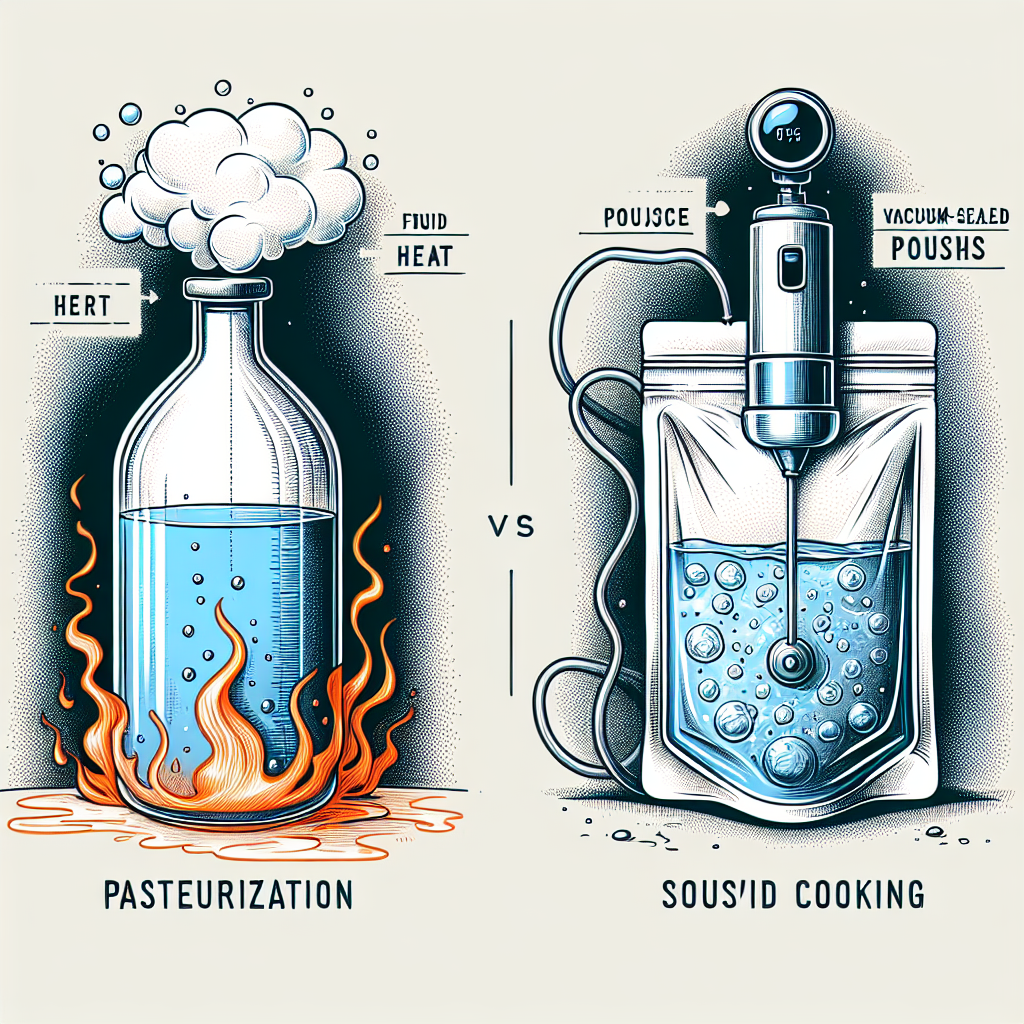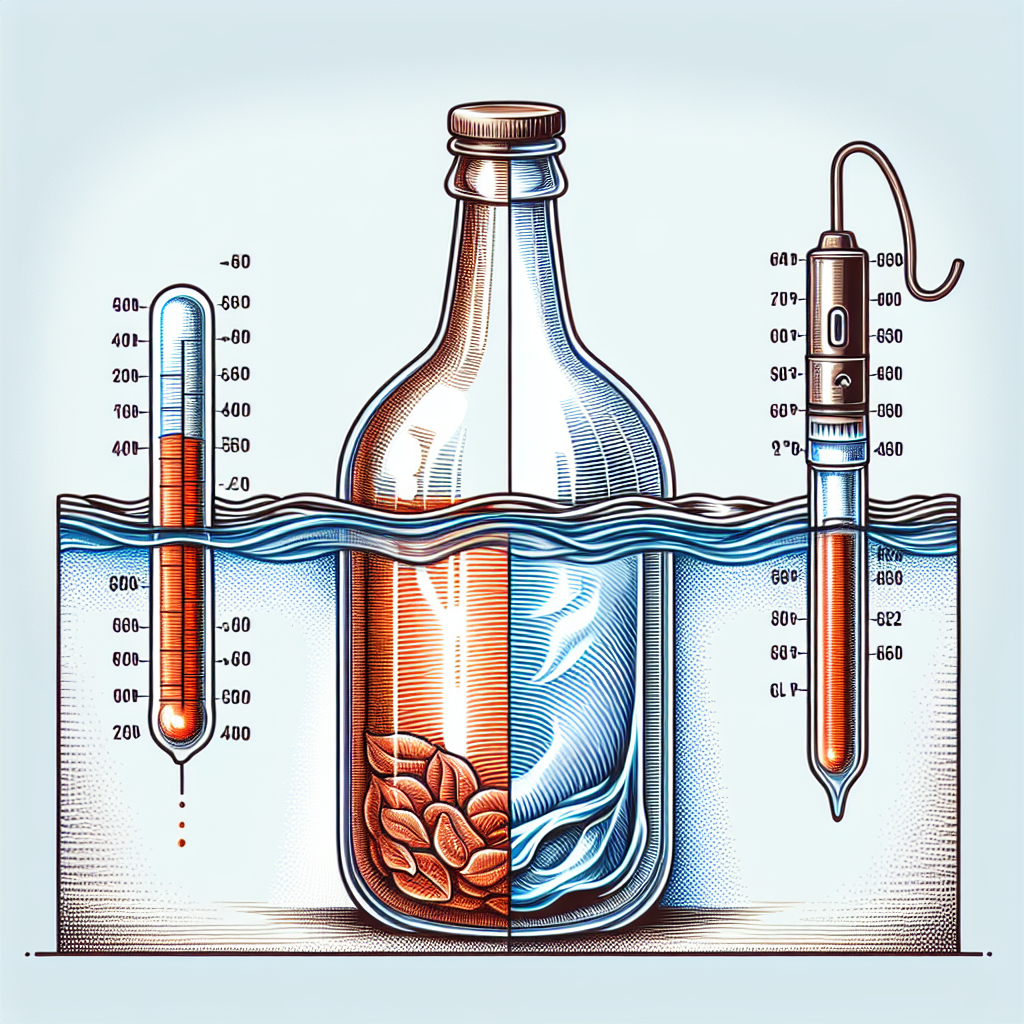
Have you ever wondered about the distinction between pasteurization and cooking sous vide? While both methods involve the application of heat, there are significant differences that set them apart. In this article, we will explore the dissimilarities between pasteurization and cooking sous vide, shedding light on how each technique operates and the unique outcomes they produce. So, let’s dive in and unravel the distinctions between these two culinary processes!
Definition of Pasteurization
Pasteurization is a heat treatment process that aims to eliminate or reduce harmful microorganisms, such as bacteria and pathogens, from food and beverages. This process involves heating the food or beverage to a specific temperature for a set period of time, followed by rapid cooling. The goal of pasteurization is to increase the safety and extend the shelf life of the product without significantly affecting its taste or nutritional value.
The process of pasteurization
The process of pasteurization generally involves heating the food or beverage to a specific temperature, typically between 60 to 85 degrees Celsius (140 to 185 degrees Fahrenheit), for a certain duration of time. This temperature range is chosen to effectively destroy or inactivate harmful microorganisms, while minimizing the impact on the quality of the product.
After heating, the product is rapidly cooled to prevent any further growth of microorganisms. The cooling process can be achieved through various methods, such as cold water baths or refrigeration. Once cooled, the pasteurized food or beverage is ready for packaging and distribution.
Purpose of pasteurization
The primary purpose of pasteurization is to ensure the safety of food and beverages by reducing the microbial load. By eliminating or reducing harmful bacteria and pathogens, pasteurization helps to prevent foodborne illnesses and extend the shelf life of products. Additionally, pasteurization can enhance the quality and consistency of certain food and beverage products, such as milk, by reducing spoilage organisms.
Definition of Cooking Sous Vide
Cooking sous vide, derived from the French term meaning “under vacuum,” is a method of cooking food in which the ingredients are vacuum-sealed in a plastic pouch and then cooked at a precise, consistent temperature in a water bath. This cooking technique allows for precise control over the cooking process, resulting in evenly cooked, tender, and flavorful dishes.
The process of cooking sous vide
The process of cooking sous vide involves several steps. First, the food is prepared by seasoning and vacuum-sealing it in a plastic pouch, which helps to retain its natural flavors and juices. Next, a water bath is set up and the temperature is precisely controlled using a sous vide immersion circulator or a water oven. The food is then submerged in the water bath and cooked for a specific duration, often longer than traditional cooking methods, to achieve the desired doneness. Finally, the cooked food is quickly seared, grilled, or finished in another way to enhance its appearance and texture.
Purpose of cooking sous vide
The main purpose of cooking sous vide is to achieve precise and consistent results. By cooking food in a controlled water bath, sous vide enables the chef or home cook to achieve perfect doneness and tenderness, even with delicate ingredients. This cooking method also helps to enhance the flavors and retain the moisture of the food, resulting in a more enjoyable and high-quality dining experience.
Temperature
Pasteurization temperature
The temperature used in pasteurization can vary depending on the specific food or beverage being processed. Generally, the temperature range for pasteurization is between 60 to 85 degrees Celsius (140 to 185 degrees Fahrenheit). This range is carefully chosen to ensure the destruction or inactivation of harmful microorganisms without causing significant changes in the taste, texture, or nutritional composition of the product.
Sous vide cooking temperature
Sous vide cooking relies on precise temperature control to achieve the desired results. The temperature for sous vide cooking can vary depending on the type of food being cooked and the desired doneness. For example, cooking a steak sous vide may involve temperatures ranging from 50 to 60 degrees Celsius (122 to 140 degrees Fahrenheit) for a medium-rare doneness. The specific temperature and cooking time are often determined through experimentation and personal preference.
Method
Pasteurization method
The method of pasteurization typically involves heating the food or beverage in a controlled environment, such as a pasteurization tank or a heat exchanger. The product is heated evenly to the desired temperature and held at that temperature for a specific period of time. This ensures that harmful microorganisms are effectively destroyed or inactivated.
Sous vide cooking method
Sous vide cooking utilizes a water bath or a water oven as the cooking medium. The cooking vessel is filled with water and the temperature is set and regulated using a sous vide immersion circulator or a water oven. The vacuum-sealed food is then submerged in the water bath and cooked at the desired temperature for a prescribed duration.
Duration
Pasteurization duration
The duration of pasteurization varies depending on the specific food or beverage being processed, as well as the target microorganisms to be eliminated. Pasteurization times can range from a few seconds to several minutes. The goal is to ensure that the food or beverage is exposed to the appropriate temperature for a long enough period to effectively reduce the microbial load.
Sous vide cooking duration
Sous vide cooking generally takes longer than traditional cooking methods. The increased cooking time allows for more precise control over the doneness and tenderness of the food. The cooking duration for sous vide dishes can vary depending on the type of food, its thickness, and the desired level of doneness. For example, cooking a thick steak sous vide may take several hours to achieve the desired degree of tenderness and juiciness.
Heat Distribution
Pasteurization heat distribution
During pasteurization, heat is typically distributed evenly throughout the food or beverage being processed. This is important to ensure that all parts of the product reach the required temperature for a sufficient amount of time. The heat distribution may be achieved through methods such as steam, water baths, or direct contact heating.
Sous vide cooking heat distribution
In sous vide cooking, heat is distributed evenly within the water bath or water oven. The water acts as a conductor, transferring heat to the food evenly from all sides. This ensures that the entire food item is cooked at a consistent temperature, resulting in uniform doneness and tenderness.
Effects on Food
Effects of pasteurization on food
Pasteurization can have various effects on food, depending on the specific product and the process parameters used. While the primary aim is to eliminate or reduce harmful microorganisms, pasteurization may also result in minimal changes in texture, taste, and nutritional quality. However, these changes are often considered acceptable and do not significantly impact the overall sensory attributes of the food.
Effects of sous vide cooking on food
Sous vide cooking can have profound effects on food due to the precise control of temperature and prolonged cooking duration. When cooked sous vide, food often retains its natural flavor, moisture, and tenderness. Meat, for example, can become incredibly tender and juicy, while vegetables can maintain a vibrant color and firmness. The controlled cooking environment also allows for the development of unique flavors and textures.
Food Safety
Food safety considerations with pasteurization
Pasteurization plays a crucial role in food safety by reducing the microbial load in products. By eliminating or reducing harmful bacteria, pasteurization helps to minimize the risk of foodborne illnesses. However, it is important to note that pasteurization does not guarantee complete sterilization, as some microorganisms may still survive or grow if post-pasteurization precautions are not taken. Therefore, proper handling, storage, and adherence to recommended expiration dates are essential for maintaining food safety.
Food safety considerations with sous vide cooking
Sous vide cooking also offers an added level of food safety. The precise temperature control and extended cooking duration allow for the effective pasteurization of foods, reducing the risk of harmful microorganisms. However, it is important to handle and cook sous vide food properly to ensure safety. This includes proper sealing, cooking at recommended temperatures and durations, and preventing cross-contamination during the cooking process. Additionally, care should be taken to rapidly cool and store cooked sous vide food at appropriate temperatures to minimize the risk of bacterial growth.

Texture and Tenderness
Texture and tenderness of pasteurized food
The texture and tenderness of pasteurized food are generally minimally affected due to the relatively mild heat treatment. Pasteurization aims to destroy or inactivate harmful microorganisms without causing significant changes in the structural integrity of the food. As a result, most pasteurized foods retain their original texture, whether it be crispness, juiciness, or chewiness. However, in some cases, high-temperature pasteurization methods may result in slight softening or changes in texture.
Texture and tenderness of food cooked sous vide
One of the standout features of sous vide cooking is the remarkable texture and tenderness it imparts to food. The precise control of temperature allows for even heat distribution, which ensures that the proteins in meat, poultry, or fish are cooked gently and evenly. This results in tender, succulent, and melt-in-your-mouth textures that are often difficult to achieve through traditional cooking methods. Vegetables cooked sous vide also retain a desirable texture with a slight crunch and vibrant color.
Flavor and Nutritional Quality
Flavor and nutritional quality of pasteurized food
Pasteurization generally has minimal impact on the flavor and nutritional quality of food. The mild heat treatment used in pasteurization aims to preserve the natural flavors and nutrients of the food while ensuring safety. However, it is worth noting that certain heat-sensitive compounds, such as enzymes and vitamins, may be slightly affected by pasteurization. Nevertheless, the changes are typically insignificant and within acceptable limits.
Flavor and nutritional quality of food cooked sous vide
Sous vide cooking is often praised for its ability to enhance the flavor of food. By cooking ingredients in a sealed pouch, the flavors are trapped, resulting in intensified aromas and more concentrated taste profiles. Additionally, sous vide cooking allows for the retention of nutrients that may be lost through traditional cooking methods, thanks to the precise temperature control and minimal exposure to excessive heat. The result is food that not only tastes delicious but also retains a higher nutritional value.
In conclusion, pasteurization and cooking sous vide are two distinct methods with different purposes and effects on food. Pasteurization focuses primarily on reducing harmful microorganisms in food and beverages, ensuring safety and extending shelf life. In contrast, cooking sous vide is a precise cooking technique that aims to achieve consistent doneness, tenderness, and enhanced flavors. Both methods have their unique benefits and considerations, and understanding them can help you make informed choices when it comes to food safety, flavor, and texture preferences.
What Is The Difference Between Pasteurization And Cooking Sous Vide?



